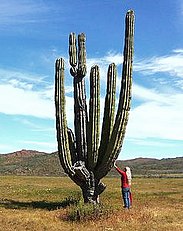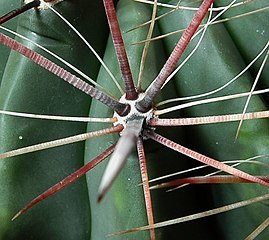Cactus is a type of plant that can store large amounts of water and survive in extremely hot and dry habitats. There are around 2000 different species of cactus that differ in size, shape, color and type of habitat. Almost all cacti are native to deserts and dry regions of South and North America. Due to their attractive morphology, cacti can be found throughout the world today. Over collecting and habitat loss are major threats to the survival of cacti in the wild. Certain species are listed as endangered, but luckily, trade of most species of cacti is prohibited by law.Cacti can survive from 15 to 300 years, depending on the species.
Size of cactus depends on the species. Largest species of cactus can
reach 66 feet in height and weigh up to 4800 pounds (when it is fully
loaded with water). Smallest species usually have only few inches in
height. Cactus can have arborescent (tree-like), cylindrical, rounded, irregular
or starfish shape. Surface can be flat or covered with ridges. Cacti have dormant periods and periods of intense growth and blossoming.
Periods of growth require enough water and sunlight and they usually
last shorter than periods of rest.

Cacti can be green, bluish or brown-green in color. They have waxy
substance on the surface which prevents loss of water via transpiration
(loss of water through small holes when outer temperature is high). Size and shape of flower depends on the species of cacti and type of
pollination. They can be white, red, orange, pink or blue in color. Butterflies, bees, moths, bats and hummingbirds are main pollinators of cacti.


Cacti have spines instead of leaves. Spines can be soft or rigid,
straight or curved, arranged in rows or scattered. They can reach 6
inches in length. Spines have two major roles: they prevent loss of water via transpiration and keep the plant safe from animals. Each spine develops from areole, which looks like a bump or nipple-like structure on the surface of the cactus. Spines of cactus can be used in the production of hooks, combs and needles. Fruit can be used as food.



Since cacti live in dry areas, they need to absorb large amount of water
and store it in the stem and roots for the periods of drought. Besides
storing of water, stem plays role in the process of photosynthesis
(production of food by using the sunlight and carbon dioxide). Water from cactus has higher density compared with tap water, but it is safe for drinking.

Roots of cacti are located few inches underground, but they can reach 7
feet in diameter because water easily passes through the sand.
References:
1. http://www.softschools.com/facts/plants/cactus_facts/501/
2. https://en.wikipedia.org/wiki/Cactus
CACTUS QUIZ
1. Where is the habitat of cacti?
a.
Dry and hot area
b.
Cold area
c.
Rainy forests
d.
Moist soil
e.
North pole
2. Where is cactus store most of the
water for the drought periods?
a.
On the spines
b.
On the flower
c.
On the stem and roots
d.
On the leaves
e.
On the areoles
3. Based on the above article, how tall
is the largest species of cactus?
a.
5 feet
b.
2 feet
c.
100 feet
d.
20 feet
e.
66 feet
4. Here are some main pollinators of
the cacti, except..
a.
Butterflies
b.
Bees
c.
Moths
d.
Bats
e.
Snakes
5. What part of the cactus that can
be used as food?
a.
Stem
b.
Spine
c.
Flowers
d.
Fruit
e.
Root
6. What is the function of spines?
a.
Prevent loss of water via transpiration
b.
Store water
c.
Make the cactus colorful
d.
Nourish the cactus
e.
For fertilization
7. What is false statement on these
statements below
a.
Roots of cacti can reach 7 feet
b.
Cacti live in dry areas
c.
Cacti store the water on the stem and roots
d.
There are 100 species of cactus in the world
e.
Size of cactus depends on the species
No comments:
Post a Comment